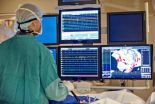(Press-News.org) The analysis of the roughly 3,000 pieces is still in its infant stage. But it is already evident that the results will be of major significance. "Amazingly often, we are finding–in addition to Asian forms–the same insect species in Fushun amber that we found in Baltic amber," explained Bonn paleontologist Professor Dr. Jes Rust.
The Baltic amber comes from the Baltic Sea region, which is almost 10,000 kilometers from Fushun. Sites rich in finds are, e.g., the coastal regions of Mecklenburg, Poland and Belarus. The pieces from the Baltic region are slightly younger than the ones from Fushun–according to estimates, about 40 to 50 million years. At that time, Europe and Asia were divided by the Strait of Turgay, a wide arm of the ocean. Many researchers had assumed until now that this body of saltwater prevented species migrations between the continents–or at least, made it much harder. "Consequently, the great similarity of the included insects has been a great surprise to us," said Rust. "We don't know yet how that fits together."
A neglected treasure
In the vicinity of the Northeast Chinese city of Fushun, there are large lignite deposits. Humans have been digging up this fuel from the ground for more than a century already. And in doing so, they also kept finding pieces of amber. Traditionally, the locals made jewelry from it. Particularly beautiful finds with interesting inclusions are highly sought after among collectors.
Until now, the inclusions had not been studied systematically. It was the Chinese paleontologist Dr. Bo Wang who finally recognized the scientific potential of Fushun amber. Wang, who is currently at the Bonn University on a research grant from the Alexander von Humboldt Foundation, used his good contacts with institutes and collectors to start systematically cataloguing the finds. An analysis is currently underway in collaboration with paleontologists from Europe and the USA.
And it is beginning to become clear how rich this deposit is. So far, the researchers have been able to identify arachnids and insects from more than 80 families–a snapshot of the past that provides a detailed view of what tiny animals populated East Asia 53 million years ago.
In addition, the Fushun deposit is filling in one of the blank spots on the map. With the exception of India, it constitutes the only significant site where amber has been found in Asia. Rust regrets that the open pit mining in Fushun will soon stop. "But despite that, the detailed analysis of the finds will probably keep us busy for quite some time."
INFORMATION:
Publication: Bo Wang, Jes Rust, Michael S. Engel, Jacek Szwedo, Suryendu Dutta, André Nel, Yong Fan, Fanwei Meng, Gongle Shi, Edmund A. Jarzembowski, Torsten Wappler, Frauke Stebner, Yan Fang, Limi Mao, Daran Zheng and Haichun Zhang; A Diverse Paleobiota in Early Eocene Fushun Amber from China; Current Biology 24 (2014); http://dx.doi.org/10.1016/j.cub.2014.05.048
Contact:
Dr. Bo Wang
Steinmann-Institute of the University of Bonn
and State Key Laboratory of Palaeobiology and Stratigraphy
Nanjing Institute of Geology and Palaeontology
Chinese Academy of Sciences (Nanjing/China)
Phone: +86 13951982860
Email: savantwang@gmail.com
Prof. Dr. Jes Rust
Steinmann-Institute of the University of Bonn
Phone: +49 228/734842
Email: jrust@uni-bonn.de END
Chinese mosquitos on the Baltic Sea
Scientists from the University of Bonn analyzing ancient insect inclusions in East-Asian amber
2014-07-30
ELSE PRESS RELEASES FROM THIS DATE:
All-in-one energy system offers greener power for off-grid homes, farms
2014-07-30
An innovative 'trigeneration' system fuelled entirely by raw plant oils could have great potential for isolated homes and businesses operating outside grid systems both in the UK and abroad.
Developed by a consortium led by Newcastle University and funded by the Engineering and Physical Sciences Research Council (EPSRC) through the RCUK Energy Programme, the small-scale combined cooling, heat and power system has been designed to provide dependable electricity without the need for a mains connection.
Ideally suited for small-holdings and businesses, and particularly ...
Toward a home test for detecting potentially dangerous levels of caffeine
2014-07-30
The shocking news of an Ohio teen who died of a caffeine overdose in May highlighted the potential dangers of the normally well-tolerated and mass-consumed substance. To help prevent serious health problems that can arise from consuming too much caffeine, scientists are reporting progress toward a rapid, at-home test to detect even low levels of the stimulant in most beverages and even breast milk. Their report appears in ACS' Journal of Agricultural and Food Chemistry.
Mani Subramanian and colleagues note that caffeine's popularity as a "pick-me-up" has led to it being ...
Hope for more accurate diagnosis of memory problems
2014-07-30
More accurate tests could be created to diagnose diseases such as Alzheimer's or memory problems stemming from head injuries, leading to earlier intervention, according to new findings from the University of East Anglia.
The research involved investigating the components of memory using a combination of tests and neuroimaging – a method that could be used to create a diagnostic tool for distinguishing between different types of dementia, memory damage from stroke or forms of amnesia caused by head trauma.
Dr Louis Renoult, a lecturer in UEA's School of Psychology, said: ...
Exploring 3-D printing to make organs for transplants
2014-07-30
Printing whole new organs for transplants sounds like something out of a sci-fi movie, but the real-life budding technology could one day make actual kidneys, livers, hearts and other organs for patients who desperately need them. In the ACS journal Langmuir, scientists are reporting new understanding about the dynamics of 3-D bioprinting that takes them a step closer to realizing their goal of making working tissues and organs on-demand.
Yong Huang and colleagues note that this idea of producing tissues and organs, or biofabricating, has the potential to address the ...
Nature inspires a greener way to make colorful plastics
2014-07-30
Long before humans figured out how to create colors, nature had already perfected the process — think stunning, bright butterfly wings of many different hues, for example. Now scientists are tapping into those secrets to develop a more environmentally friendly way to make colored plastics. Their paper on using structure — or the shapes and architectures of materials — rather than dyes, to produce color appears in the ACS journal Nano Letters.
N. Asger Mortensen, Anders Kristensen and colleagues point out that currently, plastic manufacturers add pigments to their products. ...
Fighting over proposed changes to food labels
2014-07-30
To help Americans make better decisions about what they eat, the Food and Drug Administration (FDA) earlier this year proposed significant changes to the Nutrition Facts label found on nearly every food product in the U.S. An article in Chemical & Engineering News (C&EN), the weekly news magazine of the American Chemical Society, explains the suggested updates — and the fight that has ensued.
Britt Erickson, a senior editor at C&EN, points out that while the Nutrition Facts label has remained largely the same for two decades, nutrition science has not — and neither have ...
Brainwaves can predict audience reaction
2014-07-30
Media and marketing experts have long sought a reliable method of forecasting responses from the general population to future products and messages. According to a study conducted at The City College of New York, it appears that the brain responses of just a few individuals are a remarkably strong predictor.
By analyzing the brainwaves of 16 individuals as they watched mainstream television content, researchers were able to accurately predict the preferences of large TV audiences, up to 90 % in the case of Super Bowl commercials. The findings appear in a paper entitled, ...
Brazilian researchers identify RNA that regulates cell death
2014-07-30
Researchers from the University of São Paulo (USP) have identified an RNA known as INXS that, although containing no instructions for the production of a protein, modulates the action of an important gene in the process of apoptosis, or programmed cell death.
According to Sergio Verjovski-Almeida, professor at the USP Chemistry Institute and coordinator of a research funded by São Paulo Research Foundation (FAPESP), INXS expression is generally diminished in cancer cells, and methods that are capable of stimulating the production of this non-coding RNA can be used to ...
Scientists caution against exploitation of deep ocean
2014-07-30
CORVALLIS, Ore. – The world's oceans are vast and deep, yet rapidly advancing technology and the quest for extracting resources from previously unreachable depths is beginning to put the deep seas on the cusp of peril, an international team of scientists warned this week.
In an analysis in Biogeosciences, which is published by the European Geosciences Union, the researchers outline "services" or benefits provided by the deep ocean to society. Yet using these services, now and in the future, is likely to make a significant impact on that habitat and what it ultimately ...
Ablation increases survival for adults with atrial fibrillation
2014-07-30
Ann Arbor, Mich. -- Adults who undergo a minimally invasive technique to treat atrial fibrillation are significantly less likely to die from a heart attack or heart failure, according to a long-term study by the University of Michigan Frankel Cardiovascular Center.
More than 4 million people have atrial fibrillation, an age-related heart rhythm disorder that can cause a fluttering sensation in the chest and impair the heart's ability to pump blood.
The study published in Heart Rhythm shows cardiovascular mortality dropped by 60 percent among adults who had their normal ...
LAST 30 PRESS RELEASES:
2024 Communicator Award goes to “Cyber and the City” research team based in Tübingen
A new therapeutic target for traumatic brain injury
Cosmic rays streamed through Earth’s atmosphere 41,000 years ago
ACP issues clinical recommendations for newer diabetes treatments
New insights into the connections between alcohol consumption and aggressive liver cancer
Unraveling water mysteries beyond Earth
Signs of multiple sclerosis show up in blood years before symptoms
Ghost particle on the scales
Light show in living cells
Climate change will increase value of residential rooftop solar panels across US, study shows
Could the liver hold the key to better cancer treatments?
Warming of Antarctic deep-sea waters contribute to sea level rise in North Atlantic, study finds
Study opens new avenue for immunotherapy drug development
Baby sharks prefer being closer to shore, show scientists
UBC research helps migrating salmon survive mortality hot-spot
Technical Trials for Easing the (Cosmological) Tension
Mapping plant functional diversity from space: HKU ecologists revolutionize ecosystem monitoring with novel field-satellite integration
Lightweight and flexible yet strong? Versatile fibers with dramatically improved energy storage capacity
3 ways to improve diabetes care through telehealth
A flexible and efficient DC power converter for sustainable-energy microgrids
Key protein regulates immune response to viruses in mammal cells
Development of organic semiconductors featuring ultrafast electrons
Cancer is a disease of aging, but studies of older adults sorely lacking
Dietary treatment more effective than medicines in IBS
Silent flight edges closer to take off, according to new research
Why can zebrafish regenerate damaged heart tissue, while other fish species cannot?
Keck School of Medicine of USC orthopaedic surgery chair elected as 2024 AAAS fellow
Returning rare earth element production to the United States
University of Houston Professor Kaushik Rajashekara elected International Fellow of the Engineering Academy of Japan
Solving antibiotic and pesticide resistance with infectious worms
[Press-News.org] Chinese mosquitos on the Baltic SeaScientists from the University of Bonn analyzing ancient insect inclusions in East-Asian amber


